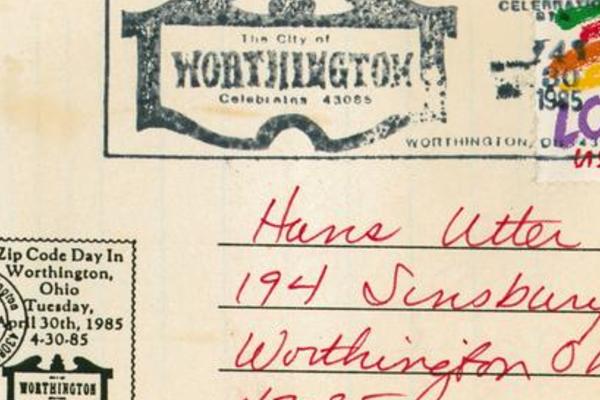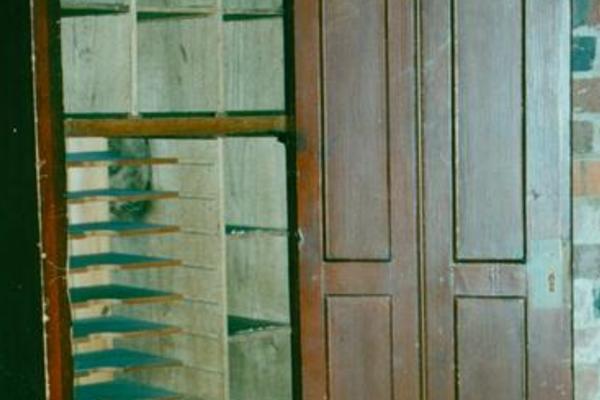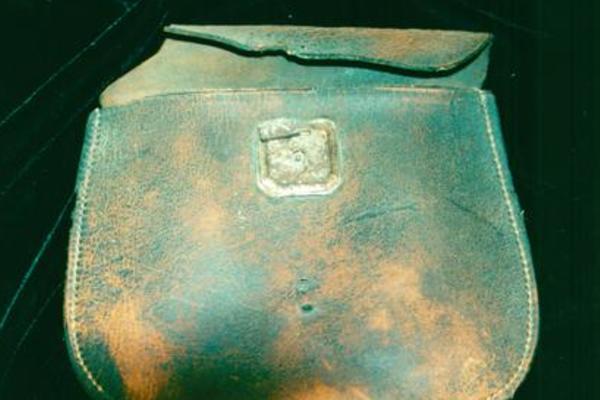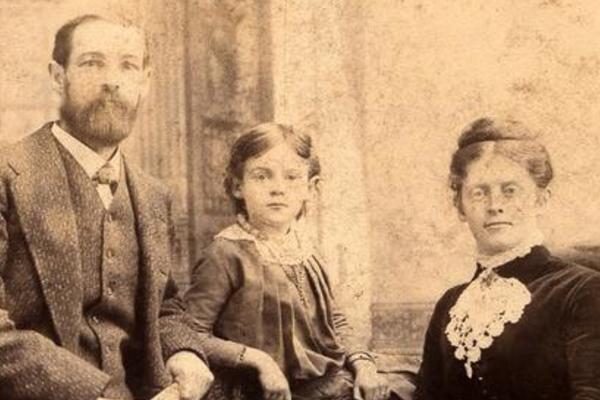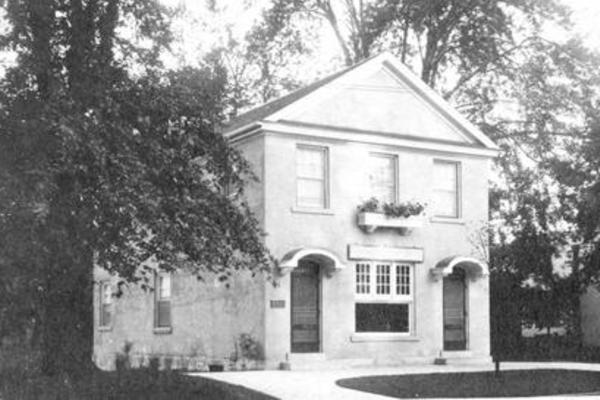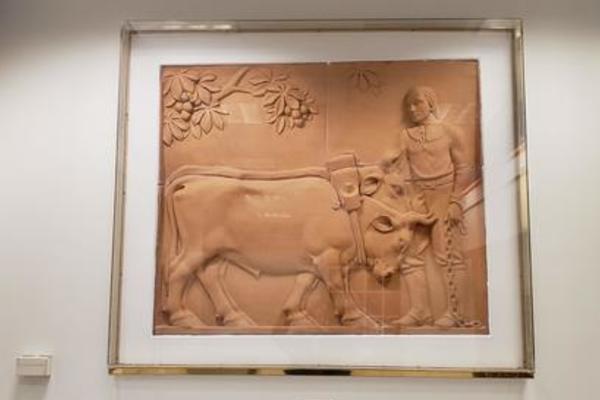Friday,
March 1, 2024
9:30am
Today, we take for granted the ease with which we can contact our loved ones. We can make a telephone call, send an email or text, connect through social media-- all using a device we can carry in a pocket. Until the 1920s, though, when telephones became common, letters were lifelines, which made postal service so important. This month, let's take a look at how postal service has helped Worthington residents stay connected with far-flung family and friends.
Postal service was much different in the early 19th century. Prior to 1847, when the first stamps were issued, the cost of delivering a letter was the recipient's responsibility, not the sender's, and partly depended on the distance it would travel. Letters were expensive, considering the average wage for skilled labor was $1.25 to $1.50 a day. A one-page letter that went 30 miles cost 6 cents, while one going 450 miles was 25 cents.
Although settled in 1803, Worthington's first post office wasn't established until 1807, which made sending and receiving mail more reliable. Nathaniel Little was Worthington's first postmaster, a title later held by George Harlow Griswold, son of Scioto Company proprietor Ezra Griswold, in the 1840s and '50s, Frank W. Bishop in 1880 and many others. Martha Sanderson became the first female postmaster in May 1869.
Under the postmaster's direction, a hired rider or courier took the village's mail to the nearest post office hub, like Franklinton, and returned with incoming mail. To collect parcels and correspondence, recipients had to visit the post office and pay for the postage.
A freestanding post office wasn't built in Worthington until the 1920s, so post office business was conducted within an existing business, like the Griswold Inn. In the early 1900s, around 1912, it was located at 677 High Street, now Denig's Jewelry. In the 1920s, it occupied a portion of 635 High Street, Fritzy Jacobs’ current home.
In April 1929, mail delivery became free in Worthington. A carrier was hired to work eight hours per day, making morning and afternoon deliveries to in-village homes with mail receptacles. That same year, the post office moved into new quarters at 11 W. New England Avenue, which adjoined the 635 High Street site. According to a "Worthington News" article on April 18, 1929, the new location served about 4,000 people.
As the village grew, so did its post office. The downtown Worthington building, located at the corner of High and Short streets, opened its doors in 1938. A March 3, 1938 "Worthington News" article noted the location served about 5,000 people, and invited readers to an open house on Sunday, March 6. "It is a one-story brick structure of colonial design, with colonial sand mold brick and green clay tile roof. / Granite steps, with wrought iron railings lead to the spacious public lobby which is 45 feet long and 12 feet wide. / The lobby is finished in birch-wood work, with molded plaster cornice on the ceiling, and has a beautiful quarry tile floor."
Commissioned for the new building and residing there still is the sculpted mural, Scioto Company Settlers. The 4-foot by 3-foot terra-cotta relief, depicting a Worthington settler standing under a buckeye tree with a pair of yoked oxen, was created by Vernon T. Carlock as part of the New Deal's Works Progress Administration.
In the late 1930s, six people were needed to maintain postal service in Worthington. By 1948, that number jumped to 17, including a postmaster and an assistant, five post office clerks and seven mail carriers. In November 1949, a Worthington Post Office branch opened in Colonial Hills, at 417 Loveman Avenue. The new location, in the basement of James T. O’Leary's home, was called Colonial Hills and Dales Post Office. O’Leary was the clerk in charge.
After World War II, the United States Post Office Department wasn't the only federal agency looking for ways to streamline and more cost effectively manage its operations, but its efforts most often generated front-page coverage in Worthington. A "Worthington News" article first mentions a plan to consolidate Worthington's post office with Columbus' in 1947. In 1953, the idea was again considered, more seriously this time, apparently, as petitions against the consolidation were circulated, signed by hundreds of residents and sent to John M. Vorys, a U.S. representative from Ohio.
A "Worthington News" editorial, published in December 1953, passionately condemned the merger: "One thing is beyond question-- this community will continue to grow and develop and as it does there would seem to be more rather than less need for a separate and independent post office to serve the community's needs. A post office is a part of the identity of a community-- just as is the church, school and fire department. …Worthington is not a satellite of Columbus-- its post office should not lose its present status."
According to a March 7, 1954 "Columbus Dispatch" article, the merger had been under consideration for a year and stated that, if approved, "Worthington would join Whitehall, Bexley and Upper Arlington as Columbus branches." The same article notes Worthington's post office-- which serviced smaller offices in Linworth, Dublin and Powell-- had 21 employees and 16,429 customers.
In March 1954, the U.S. Post Office Department recommended the consolidation, citing improved services and an annual savings of $10,500.
Despite a federal recommendation, the merger didn't happen for another 13 years. Worthington's post office became a classified branch of the Columbus Post Office on July 28, 1967, a date that coincided with the retirement of Worthington Postmaster Stephen M. Snouffer, who had held the position since August 1955. A "Columbus Dispatch" article, dated July 25, 1967, reported that the office's name, workers and duties would not change.
The Committee for Preservation of the Worthington Post Office, made up of representatives of local businesses-- including the "Worthington News"-- and the chamber of commerce, circulated petitions against the post office transfer and even met with U.S. Post Office Department officials to plead their case. Although the efforts were unsuccessful, the group received commitments that locally cancelled mail would retain a Worthington postmark, that local customers could continue using "Worthington, Ohio" as their mailing address and the name on the building would stay the same, among other things.
A year after the merger, in a Nov. 28, 1968 editorial, the "Worthington News" conceded the issue, expressing gratitude the city was permitted to keep its postmark "and hence our identity."
Also unchanged by the consolidation was the city's zip code, which went into effect, as they did nationally, on July 1, 1963, speeding up mail deliveries and reducing the chance of misdirected mail. A "Worthington News" article reported on the city's assigned zip code, 43085, in June 1963. More than 20 years later, the city celebrated its five-digit identifier during Zip Code Day. On April 30, 1985 (4-30-85), a distinctive postmark, designed by the U.S. Postal Service, was used to cancel letters at a special postal station at the Worthington Public Library.
Although the committee that worked with postal officials to plan Zip Code Day festivities didn't expect to reconvene for another 100 years, news about the proposed location of a new post office brought the group together only two months later.
The organizers, which included representatives from the city, school district, library, arts council and businesses, met in July 1985 to discuss the post office's plans to build a new office. Postal officials were looking for feedback about the proposed location, which was on the northwest corner of Dublin-Granville Road and Pingree Drive. The group was not in favor of the site, not only because it was in a residential area, but also because they believed any new post office facility should be in downtown Worthington.
Post office planners had been on the hunt for a lot on which to build or an existing building to remodel since 1983. Worthington had outgrown the existing downtown post office. News articles from the early 1980s about the location frequently mention long lines and lack of parking. In a Jan. 26, 1984 "Worthington News" article, Worthington post office manager Pat Somers acknowledged, "We're 80 percent undersized." The same article states that planners were looking for a lot north of Route 161, south of Wilson Bridge Road, west of Route 23 and east of Olentangy River Road. The facility would keep the 43085 zip code, serving 43,000 people.
The site proposed in the summer of 1985 was actually three parcels of land at 310 E. Dublin-Granville Road. However, in addition to members of the Zip Code Committee, a number of residents did not approve of the land choice. In its Sept. 5, 1985 edition, the "Worthington News" reported that "A crowd of nearly 500 filled seats and bleachers at the Worthington Community Center…to protest the proposed location of a new Worthington Post Office." Although at the meeting Columbus Postmaster Gene L. Scott stopped short of promising not to build, he told the "vocal but orderly crowd" officials would search for alternative sites.
And search they did. Unfortunately, the site proposed in the fall of 1985, at Linworth and Snouffer roads, again did not meet community expectations. Concerns at a November 21 public meeting were similar to those expressed a few months earlier, namely that the site was in a residential area and problems with additional commercial development, traffic, noise and safety were anticipated. This meeting, however, was different in a meaningful way from the previous gathering; Frank Gifford, president of Continental Realty, offered to help the post office find a suitable location with the appropriate zoning.
In March 1986, the "Worthington News" reported that the U.S. Postal Service had decided on a site for the new post office. It was one identified by Gifford, in the Brookside Business Park just west of Linworth on Route 161. Construction was estimated to take about two years.
Over the years, stopgap efforts had been made to relieve pressure on the downtown Worthington post office until a larger facility could be built. At least two contract branches opened in 1984 and 1985. Customers could buy stamps, drop off letters, purchase money orders, etc. in the Corporate Copy Center at the Worthington Square Shopping Center and inside Colonial Coffee Merchants in Linworth. A full-service postal station opened at 905 Schrock Road, at the southeast corner of Busch Boulevard and Schrock, in September 1985.
In July 1987, more than a year into construction of the new facility, postal officials announced further efforts to relieve overcrowded conditions, by moving almost half of the Worthington post office routes to temporary quarters in the northwest area within a few months. The "Worthington News” article covering the temporary mail distribution center, dated July 15, 1987, may have been some residents first indication that their zip code could change. "About half of the 19,000 Franklin County mailing addresses which now have the Worthington 43085 zip code will change to Columbus 43235, just as soon as the temporary post office is open," Postmaster Scott is quoted as saying. The change would apply to addresses north of Interstate 270 and west of the Olentangy River.
Residents affected by the zip code change enlisted the help of Worthington City Council, which agreed to request a hearing with postal officials. Although there is no mention in local news outlets about whether the meeting took place, according to maps released by postal officials in October 1987, portions of the City of Worthington west of the Olentangy River that had been slated to change to 43235 kept the 43085 zip code.
Congressional cuts delayed construction of the West Worthington Post Office, as it was named, but mail carriers continued working out of temporary quarters on Kenny Road until the post office opened in March 1989 at 6316 Nicholas Drive.
In 1997, the downtown Worthington post office was among 36 Columbus area offices included in a $22 million makeover. The branch received the "postal store" treatment, which meant self-serve vending equipment, more post office boxes and a new entrance on Short Street. Carriers were also relocated to the postal facility at Busch Boulevard and Schrock Road, freeing up parking spaces for customers.
Self-serve vending equipment? Long, long gone are the days when Worthington’s postal services were situated in an inn and residents required to pick up and pay for precious letters and correspondence. Communication methods may have changed since 1807, but in postal facilities across the country, including in Worthington, employees continue their work to keep communities connected.

